Japan
Wood Products Prices
Dollar Exchange Rates of 25th
March 2016
Japan Yen 113.09
Reports From Japan
To raise the consumption tax or not?
The Japanese government has reassessed the state of the
economy and citied weakness in consumer and corporate
sentiment as undermining the progress made to-date.
Domestic weakness is exacerbated by due to uncertainty in
global markets and a slowdown in emerging economies.
The Cabinet Office, in its latest assessment, says the
economy is “on a moderate recovery, while weakness can
be seen recently,” a more negative picture than last month
when it said weakness in the economy was “in some areas
only”. The March assessment is the first downward
revision since October last year.
Over the next few months the government will decide
whether to go ahead with its 2017 increase in the
consumption tax but the Prime Minister has always said
the change will only be made if conditions are right and
that it will not go ahead if, for example, there is a
significant contraction in the global economy.
The February consumer sentiment report released by the
Cabinet Office reported a decline in the consumer
confidence index for the second straight month.
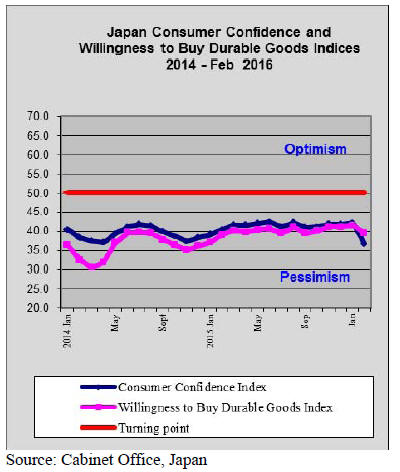
Analysts expect the yen to continue to strengthen
With little room to seriously impact the yen dollar
exchange rate the Bank of Japan (BoJ) will be looking for
the US Federal Reserve to come to its rescue with an
interest rate rise. The BoJ has the option of lowering rates
further into negative territory but experience from the
most recent dip into those waters was less than successful.
Over the past few months the yen has strengthened
significantly against the US dollar and major currencies
and analysts expect the yen to continue to strengthen.
A spike in the yen is anticipated in April when
Japanese
companies repatriate overseas earnings to close their
2015/16 books.
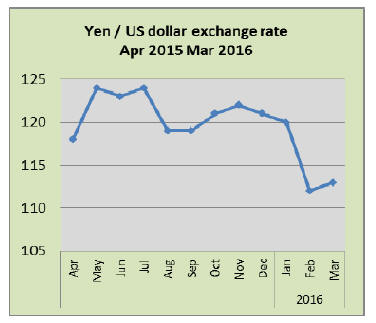
Cheap money pouring into the Japan’s housing
market
Outside of the main urban areas land prices in Japan
continue to fall, the result of urban drift and the aging
population in rural areas.
Recent data from the government shows that January 2016
prices for land in 31 of the country's 47 prefectures were
down year on year. In some areas the decline is extreme,
for example in, Akita prefecture commercial land values
are now 40% below their 2008 level.
In contrast to the situation in rural areas prices in urban
areas are rising fast as cheap money pours into the real
estate market. The extent of recent increases in
condominium prices in the main cities is making
conveniently located housing unaffordable for families.
Negative interest rates have driven down mortgage rates
and efforts by commercial banks to expand housing loans
have boosted demand for property.
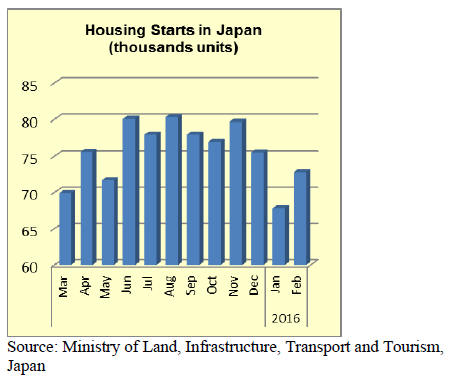
Import round up
Doors
Year on year January 2016 imports of wooden doors were
up 8% but compared to December last year there was a fall
in imports.
China remains the main supplier of wooden doors to Japan
followed by the Philippines and Indonesia. These three
suppliers dominate imports of wooden doors accounting
for over 85% of all imports of doors.

Windows
Year on year, Japan’s January 2016 wooden window
imports were slightly up but this disguises the sharp
decline in imports of windows since November 2015. In
fact, January 2016 marked the lowest point in imports
since March 2015.
As is the case with wooden doors, China is the number
one supplier accounting for almost 40% of January
imports. The other main suppliers are the Philippines
(28%) and the USA (20%). Suppliers in the EU accounted
for just over 11% of January imports.
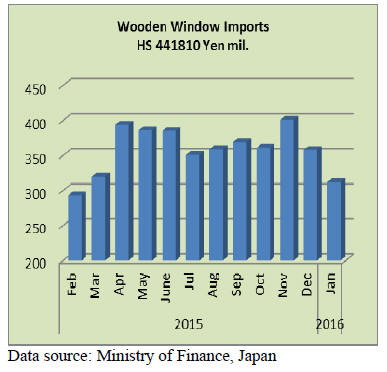
Assembled flooring
Year on year, January 2016 imports of assembled flooring
dropped 7% but were up on levels seen in December 2015.
Suppliers in Asia dominate Japan’s imports of assembled
flooring accounting for over 85% of imports. Suppliers in
the EU captured a 12% share of January 2016 imports.
Since September 2015 imports of assembled flooring have
trended higher but have not yet reached the levels recorded
in May and June last year.
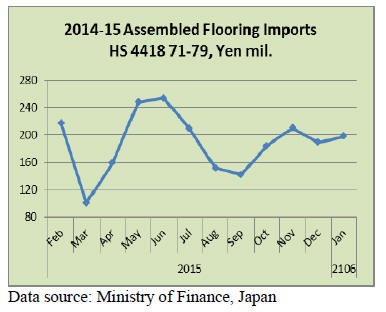
Plywood
January 2016 plywood were the second highest since
January 2015 and edged closer to the peak recorded in
October last year. But, year on year, January 2016
plywood imports were down 12% because January 2015
imports were very high.
The top three suppliers accounted for 94% of all Japan’s
January plywood imports. However, China’s shipments
dropped 30% year on year, Malaysia shipments were
down 21% in January this year but Indonesia secured an
advantage as shipments increased 12%.
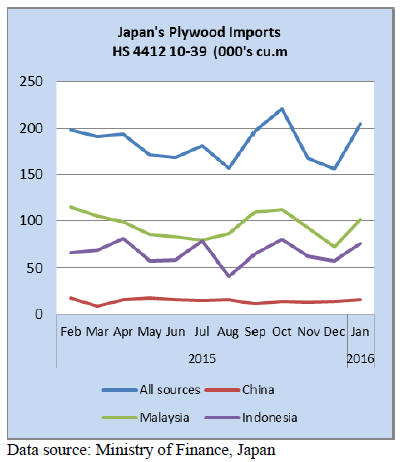 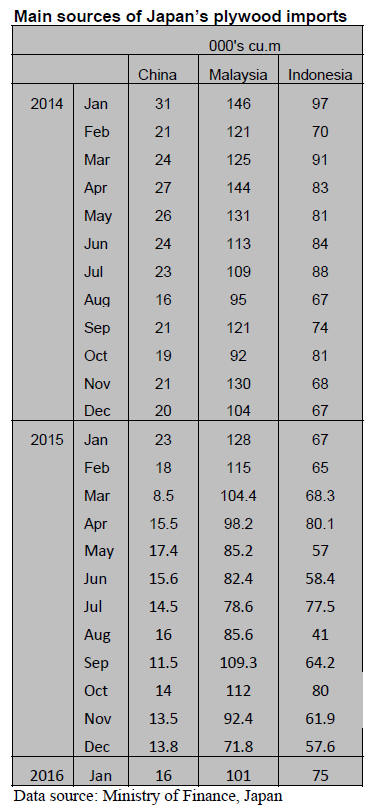
Trade news from the Japan Lumber Reports (JLR)
For the JLR report please see:
http://www.nmokuzai.
com/modules/general/index.php?id=7
Business collaboration with Indonesian MDF
manufacturer
Sumisho & Mitsui Bussan Kenzai Co., Ltd. (Tokyo),
SMBK and Noda Corporation (Tokyo) concluded business
collaboration agreement with Indonesian MDF
manufacturer, IFI (Indonesia Fiberboard Industry,
Jakarta).
The agreement includes technical advice and marketing of
MDF in Japan. Two Japanese companies intend to expand
demand of MDF made of tropical hardwood species,
which has high water resistant performance. It is used for
building materials and fixtures.
IFI has MDF plant south of Jambi in Sumatra, which
started the operation in September 2012. It had been
selling the products to Indonesian domestic and
neighboring markets then it acquired JIS certification on U
type in September last year and M type in March this year
so it is ready for Japan market.
IFI’s monthly production is 20,000 cbms and three
companies aim to ship 3,000 cbms a month for Japan by
the end of 2016.
SMBK has an exclusive importing right for Japan and
Noda will market all in Japan. Noda will use MDF as base
material for its own building materials and sell it at open
market with brand name of ‘Hi Bestwood’. Noda will
market through SMBK to other building materials
companies and processing companies.
Radiata pine log and lumber import in 2015
Import of radiata pine logs and lumber in 2015
considerably decreased from 2014 because demand for
crating lumber and pallet remained sluggish despite weak
yen of about 120 yen per dollar.
Imports of New Zealand radiata pine logs was 421,850
cbms, 20.2% less than 2014 and radiata pine lumber was
75,936 cbms, 10.5% less. Chilean radiata pine lumber
import was 222,353 cbms, 14.3% less.
Weak yen should be favorable factor for export industry of
Japan but there was difference by items. Particularly,
export for China dropped by dwindling Chinese economy
then export for neighboring countries like Korea, Thailand
and Philippines, which were also influenced by slowdown
of China market, also dropped, which impacted overall
demand of crating lumber.
Because of slump of crating lumber demand, radiate pine
sawmills in Japan reduced the production by about 20%,
which resulted in lower demand for radiata pine logs.
Chilean radiata pine suppliers planned eight shipments to
Japan in 2015 but the last one delayed into this year to
become the first shipment of 2016.
In 2014, demand for the U.S.A, and China was very active
so that Chilean sawmills operated in full but in 2015,
Chilean sawmills reduced the production because China
demand slowed down and competition with European
lumber in the Middle East market got fierce.
By worldwide retreat of the demand, Chilean lumber
supply has more room so that the export prices have been
revised downward, trying to take market share back,
which Chilean lost in competition with Japanese radiata
pine sawmills. Radiata pine crating lumber competes with
domestic larch and cedar crating lumber.
South Sea (tropical) logs
In Sabah and Sarawak, Malaysia, log harvest and
transportation were temporarily disrupted by the Chinese
New Year in February so price negotiations stopped since
late January then the business resumed since late February.
Log procurement was difficult since late last year
through
late January. Particularly, supply of large logs with
diameter of more than 60 centimeter, which Japan market
looks for, has been tight. Unless combining with small and
super small logs, it is impossible to have necessary
volume. Japanese users would rather pay higher prices for
quality regular logs as recovery and production efficiency
are better.
Despite lower log production, the log suppliers sales
attitude is not bullish because India, the largest log buyer,
has been absent since last December so the export log
prices are unchanged from last month.
Log supply in Sarawak is limited by new restriction of
monthly harvest. Even if harvest exceeds allowed monthly
volume, carryover to next month is not allowed by law so
the suppliers limit the harvest about 90% of allowable
volume.
In Sabah, some supplier has acquired new timber tract,
which produces about 1,500-2,000 cbms of logs for Japan.
Present export prices are US$265-275 per cbm FOB on
Sarawak meranti regular, US$245 on small and US$230
on super small. They are all weakly holding.
Toyo Materia markets 100% FSC certified plywood
Toyo Materia (Tokyo) announced that it will start selling
100% FSC certified coated concrete forming plywood
since this month.
This is the first time to have 100% certified plywood of
tropical hardwood. Toyo Materia has been importing
certified plywood since 2008 about 1,500 cbms a month.
The supplying company is Intracawood Manufacturing of
Indonesia. This company uses logs from FSC certified
timberland of 195,000 hectares. Coating is done by Sen-ei
Co., Ltd. (Kishiwada, Osaka prefecture). Oil urethane
coating is done four times. Color is olive green, which is
different from other coated concrete forming panels.
Monthly production is 30,000 sheets.
FSC.COC project chain is certified including Sen-ei so
that distribution channel to final shipment is certified.
Each sheet has FSC certified stamp on the back so it is
easily acknowledged. Domestic coating is convenient for
users by easy delivery.
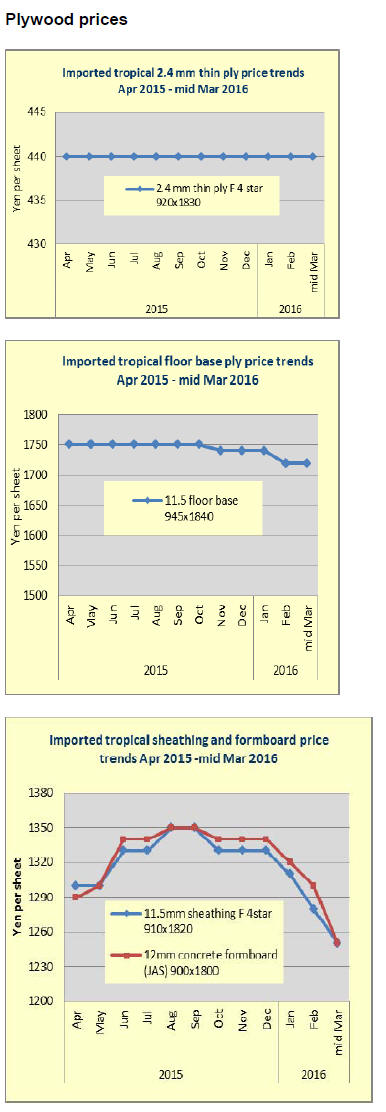
Specifications on export lumber to be made
The Japan Wood Products Export Association has set up a
committee to make up specifications of lumber exported
for other countries. It also plans to have a permanent
display ‘Japan Wood Station’ in Vietnam, where all kind
of Japanese wood products are exhibited. This is to
develop the market in Vietnam.
Wood products export in 2015 was 26.3 billion yen,
24.8% more than 2014. Initial target was 25 billion yen by
2020 so the target has already been achieved way ahead of
time. In this, logs were 690,000 cbms, 32.7% more then
lumber was 60,000 cbms, 10.6% less. In order to increase
lumber export, the committee will prepare export
specifications on lumber such as quality and sizes.
China and Taiwan are two major target. The export
specifications is voluntary system but the main objective is
to give more reliability of Japanese made lumber in
foreign markets.
In the past, the main markets were China, Korea and
Taiwan. Now Vietnam is another target so the exhibition
of wood products should advertise to use Japanese lumber.
Vietnam has large whitewood furniture processing
industry for export so there should be ample demand of
Japanese softwood such as cedar and cypress, which are
used for export furniture to the U.S.A. and European
countries then also for interior finishing materials for
Vietnamese housing.
The Association is also considering to invite Vietnamese
furniture manufacturers to Japan to show what type of
material Japan can supply For Taiwan, the main item is
logs but in future, target is to develop demand for
plywood, LVL for window and door frame. Also Taiwan
is active in exporting furniture so it will investigate to see
if Japanese wood can be used for furniture manufacturing.
|